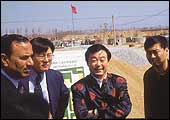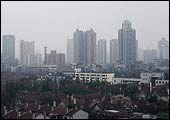 |
| AUROBINDO PHARMA
may well have hit upon the ideal entry strategy into China.
In 1998, it formed a JV with Shanxi Tongling to set up Aurobindo
Tongling. Now, Aurobindo is investing $50 million (Rs 244 crore)
in a 100 per cent subsidiary. Tongling may have nothing to do
with the new venture but its Chairman, Hanyan Lin (second, from
right, below), is thrilled to show people around the plot where
the Aurobindo plant will come up. Estimated start of production:
August 2002. |
Not all multinationals are here because of the
infrastructure or the cheap cost of doing business. "I wouldn't
compare the quality of infrastructure here with that in Hong Kong
or Canada or Mexico," says Michael Furst, the Executive Director
of the American Chamber of Commerce in Beijing. "But it has
improved relatively." As for the cost of doing business, adds
Furst, it may be less in China than in Western Europe or the US,
"but there are a number of other places like Thailand or Indonesia
that are cheaper."
If these companies are in China, then, it is
because the country is a market that just can't be ignored. At 900,000
units a year, the size of the Chinese car market isn't large, but
by 2025, it is expected to touch 16 million units a year. "Already,
38 million urban families can afford to pay 100,000 yuan (Rs 5.9
lakh) for a car," says Gallup's Guo. And, as everyone who has
been reading the papers knows, China boasts the world's largest
mobile phone market. The huge market has its advantages. ''The Chinese
really understand the volume manufacturing business," points
out Prakash Menon, the General Manager of NIIT China, Shanghai,
(a general manager in China is the equivalent of a CEO elsewhere).
Menon's argument: the domestic market's size, apart from factors
like the quality and cost of infrastructure and labour, helps the
Chinese cut production costs and is the source of their global competitiveness.
Only, the Chinese domestic market isn't one
homogeneous mass buzzing with growth angst. By 2001, 83 per cent
of the products and services sold in China were in over-supply mode.
"We are in the midst of a transformation," explains Guo.
"From a shortage economy to a surplus one; from deflation to
price wars between companies; and from an era of stable jobs to
one of layoffs." There's more: channel costs in China have
traditionally been high and it is only now, with the emergence of
large organised retail chains, that these are coming down. Product
penetration levels in the top 20 per cent of the population in China's
four largest cities range from 91 per cent for cameras, through
97 per cent for refrigerators, to 100 per cent for colour televisions.
Ergo, in some categories-fast moving consumer goods, for instance,
where the likes of Unilever have found the going tough in a market
where 35-40 per cent of products sold are fakes-the domestic market
isn't growing, it is shrinking.
 |
| SHANGHAI'S SKYLINE
would put Manhattan to shame. By some estimates, over 20,000
skyscrapers have come up in the city in the past 10 years. For
the trivially inclined, the city was once home to 18 per cent
of the 'sky scraper cranes' used to build high-rises. Even today,
it is home to 15 per cent of them. But the hectic construction
has caused a glut: close to 40 per cent of residential and commercial
space in Shanghai is empty, and the city just doesn't have the
retail traffic to support all the stores that have opened. |
Exacerbating things is the growing divide between
the rich and the poor, and the decrease in salaries that inevitably
accompanies the government's efforts to restructure SOEs. Shanghai's
steel-workers-turned-cabbies, for instance, have seen their salaries
fall from 2,000 yuan (Rs 11,805) a month to 800 yuan (Rs 4,722).
Cooked Goose; Cooked-Up Numbers
If last year's popular refrain concerned China's
ability to become an economic superpower then, this year's has been
the "Coming Collapse Of China" (also the name of Gordon
Chang's recent best-seller). Going purely by reports in the media,
nothing is right in China: its economic statistics are cooked up;
workers at SOEs are rioting because they don't like being laid off
(or they simply want to be paid); and the government's huge spends
on infrastructure-another $40 billion-odd (Rs 195,419 crore) will
be spent over the next six years, just on getting Beijing ready
for the Olympics-have caused the country's fiscal deficit to swell.
Some Chinese believe much of this criticism
stems from the US' efforts to ''do to China now, what it did to
Japan in the 1980s''. "I think the coverage has been a little
harsh," says Brahm of the Naga Group. Liu Jin Ping of Shanghai's
Foreign Economic Relations and Trade Commission doesn't budge from
the figure of 7.8 per cent growth in GDP ''that was mentioned at
the People's Congress," and says the truth must be evident
in "China's thriving domestic economy''.
 |
"Infrastructure is the key to attract
companies to invest in China."
Laurence Brahm, CEO/Naga Group |
Most foreign companies operating in China are
veering around to the view that even if the GDP didn't grow by 7.8
per cent, it must have certainly grown by over 5 per cent. And that,
in an economy with a GDP of over a trillion dollars, isn't an insignificant
rate of growth. "I don't think there is a doomsday scenario,"
says Furst of Am-cham. If there is one number that indicates the
solidity of the Chinese economy, though, it is the accumulated savings
of its people: some 6,500 trillion yuan ($785.34 trillion, or Rs
38,36,81,100 crore) at the end of 2001. A portion of this (no one
quite knows how big) goes into government bonds that fund infrastructure
projects.
 |
"There are a number of otehr places
like Thailand or Indonesia that are cheaper."
Michael Furst, ED/American Chamber
of Commerce, Beijing |
China's fiscal deficit, at 3 per cent of GDP
isn't as scary as India's 5.3 per cent, but that isn't the worst
of the country's problems: creating a social safety net and narrowing
the gap between the rich and the poor are. China has set the first
in motion-but the 53 per cent rule may just end up making life tougher
for soes that employ over 50 per cent of the country's workforce-and
is hoping growth in the services sector and the government's diktat
to businesses and investors to "Go West" to the under-developed
hinterland will solve the second. "The most important means
to reduce the gap between the rich and the poor is the taxation
policy, which means to help the groups who are yet to get rich through
our taxation policy. I believe that this problem will be solved
after a certain period of time," said Chinese Premier Zhu Rongji
in his address at the recently concluded People's Congress.
 |
"We must grow at a minimum of seven
per cent to ensure that the benefits of reforms percolate to
rural areas."
Michael Guo, GM (Beijing)/Gallup |
Still, there are enough positives that point
to this being China's century. The first is the ability of the Chinese
to take an idea and act on it. Then, there is the Chinese political
and administrative system. Autocratic it may be, but China has managed
to evolve two parallel streams of governance that work well for
it. The first is the administrative layer: from deputy mayors to
the Premier, who take care of the business of administration. Most
people in this layer are educated (highly qualified would be the
term to use if one is comparing them to Indian politicos). The second
is the Party-layer. ''This runs right to the top, alongside the
other stream, and is a way to reward outstanding party workers without
really giving them positions they cannot manage,'' explains Menon
of NIIT. Corruption is an issue, but the fact that the only way
individuals can rise up the hierarchy is through performance-a mayor,
for instance, would be appraised on his ability to attract foreign
investment and develop the region under his control-ensures that
it doesn't hamper growth. Finally, the Chinese have developed the
art of compartmentalising things. Thus, rather than try and address
all issues facing the economy, the Chinese leadership has earmarked
some of them, such as the one concerning NPLs, for the next generation
of leaders.
How that eventually works out is debatable,
but by most counts, the Chinese are unlikely to let their economy
flag till 2008; they'd hate to have anything spoil their Olympics
party. If they can keep it going past 2008, China could well become
the world's largest economy by the middle of the century (some analysts
say sooner). If they can't, the fabled middle kingdom could find
itself where it was in 1980, perhaps worse off. End word: As Rongji
said at the People's Congress, "China's kung-fu (economics)
is fairly good." For now.
-additional reporting by Ashish
Gupta
1
2 3
|

